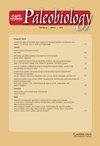盗蛋建筑师:实验窃蛋龙筑巢生理,成虫介导孵化的可能性,以及间接接触孵化的可行性
IF 2.7
2区 地球科学
Q2 BIODIVERSITY CONSERVATION
引用次数: 1
摘要
许多高质量的生殖相关的窃蛋龙化石已经被描述。然而,在现存的动物中,窃蛋龙式的巢是未知的,它们奇怪的结构使得筑巢行为难以解释。实验是为了更好地了解窃蛋龙的筑巢策略。根据最新的巢重建,他们用沙子和36个不育的鸸鹋蛋(与巨石器蛋近似)建造了一个假蛋,并将其放置在假蛋龙的巢上。放置在每个蛋内和整个实验区的温度计记录了从替代恐龙进入筑巢微环境的能量流。一项实验检查了一个基本的开放式巢穴,从上面加热;第二个是一个完全埋在地下的离合器,从上面温暖着;第三个,一个像第一个一样开放的巢,但有加热元件(代表后肢)延伸到巢中。研究发现,在每种情况下,鸡蛋的温度都超过了环境温度,而不需要过多的能量输入。最后的孵化温度低于大多数鸟类的值,更接近鳄鱼的孵化,但可能是保守的,考虑到实验参数。这些结果可能支持了一种观点,即窃蛋龙可以利用成年龙产生的能量在环境条件下加热卵窝。此外,如果由巢内的元素(如后肢)加热,而不是仅仅从上面加热,卵层的温度会更温暖,也更均匀。第二个实验的结果表明,尽管有屏障,吸热成虫可能会给完全埋在自己下面的一窝幼崽保暖。尽管窃蛋龙不太可能表现出这种行为,但这些结果表明,一个重要的进化步骤连接了受保护的地下蛋和接触孵化的地下蛋。本文章由计算机程序翻译,如有差异,请以英文原文为准。
The egg-thief architect: experimental oviraptorosaur nesting physiology, the possibility of adult-mediated incubation, and the feasibility of indirect contact incubation
Numerous, high-quality reproduction-related oviraptorosaur fossils have been described. However, oviraptorosaur-style nests are unknown among extant animals, and their curious construction makes nesting behavior difficult to interpret. Experiments were undertaken to better understand oviraptorosaur nesting strategies. A surrogate was constructed and placed atop mock-oviraptorosaur nests built from sand and 36 infertile emu eggs (as Macroolithus approximations) arranged according to the most current nest reconstructions. Thermometers, placed within each egg and throughout the experimental area, recorded energy flow from the surrogate dinosaur into the nesting microenvironment. One experiment examined a basic open nest warmed from above; the second, a fully buried clutch warmed from above; and the third, a nest open like the first but with heating elements (representing hindlimbs) extending down into the nest. It was found that egg temperatures in each scenario surpassed ambient temperatures without requiring excessive energy input. Final clutch temperatures were below most avian values, closer to crocodilian incubation, but are likely conservative, considering experimental parameters. These results may support the idea that an oviraptorosaur could use adult-generated energy to warm a clutch above ambient conditions. Additionally, egg tiers would be warmer and more uniform in temperature if heated by elements within the nest, such as hindlimbs, instead of solely from above. Results from the second experiment indicate that an endothermic adult could possibly warm a clutch fully buried beneath itself despite a barrier. Although not likely a behavior exhibited by oviraptorosaurs, such results suggest an important evolutionary step bridging guarded subterranean eggs and contact-incubated subaerial eggs.
求助全文
通过发布文献求助,成功后即可免费获取论文全文。
去求助
来源期刊

Paleobiology
地学-古生物学
CiteScore
5.30
自引率
3.70%
发文量
38
审稿时长
>12 weeks
期刊介绍:
Paleobiology publishes original contributions of any length (but normally 10-50 manuscript pages) dealing with any aspect of biological paleontology. Emphasis is placed on biological or paleobiological processes and patterns, including macroevolution, extinction, diversification, speciation, functional morphology, bio-geography, phylogeny, paleoecology, molecular paleontology, taphonomy, natural selection and patterns of variation, abundance, and distribution in space and time, among others. Taxonomic papers are welcome if they have significant and broad applications. Papers concerning research on recent organisms and systems are appropriate if they are of particular interest to paleontologists. Papers should typically interest readers from more than one specialty. Proposals for symposium volumes should be discussed in advance with the editors.
 求助内容:
求助内容: 应助结果提醒方式:
应助结果提醒方式:


